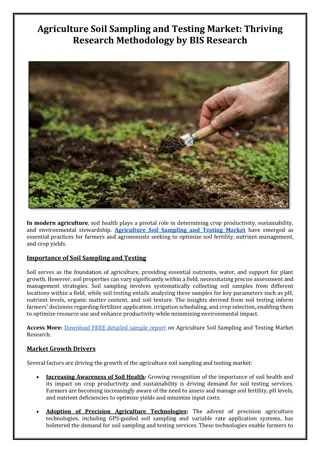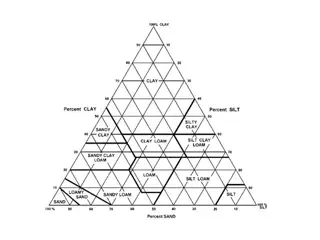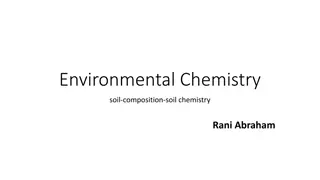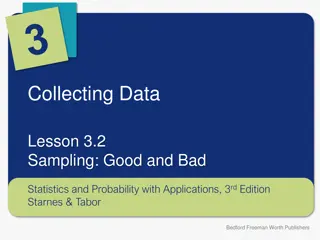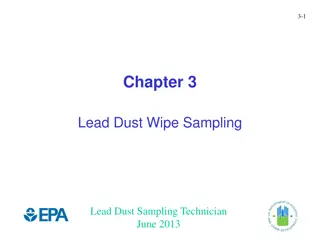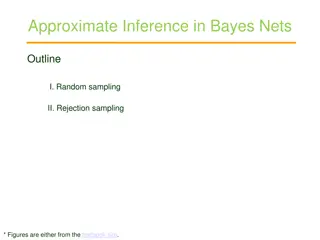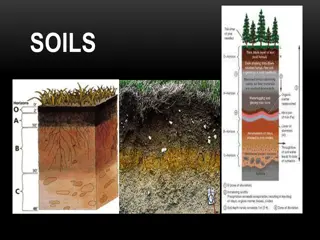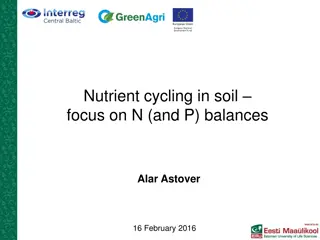Soil Sampling and Testing for Nutrient Analysis
Soil sampling and testing is a crucial process to assess nutrient status and make fertilizer recommendations. The key steps include sampling, soil preparation, nutrient extraction, and data interpretation. Sampling should be done before planting, with proper labeling and using clean tools. Soil samples need to be dried, ground, and sieved in the laboratory for analysis. Results are expressed on an oven dry basis, aiding in informed decision-making for crop nutrient management.
Download Presentation

Please find below an Image/Link to download the presentation.
The content on the website is provided AS IS for your information and personal use only. It may not be sold, licensed, or shared on other websites without obtaining consent from the author.If you encounter any issues during the download, it is possible that the publisher has removed the file from their server.
You are allowed to download the files provided on this website for personal or commercial use, subject to the condition that they are used lawfully. All files are the property of their respective owners.
The content on the website is provided AS IS for your information and personal use only. It may not be sold, licensed, or shared on other websites without obtaining consent from the author.
E N D
Presentation Transcript
Soil sampling and testing Soil testing Soil testing is an acceptably accurate and rapid soil chemical analysis for assessing available nutrient status for making fertilizer recommendations. The major steps in practical soil testing are: 1. Soil sampling 2. Preparation of soil sample 3. Extraction/ analysis of available nutrients by an appropriate laboratory method 4. Interpretation of soil analysis data
Soil sampling and testing 1. Soil sampling Soil sample must be true representative field or the part of the field being tested. of the The figure provides the suggested procedure for a small field and for a large field (Peck and Melsted, 1967). sampling Contd
Soil sampling and testing Best time for sampling is before sowing or planting. Each sample should have a label describing field identification, farmer s name and address, previous crops, and the crop for which nutrient recommendation is sought. Abnormal soil patches, areas near a fence or used for storing animal manure or crop residues should not be sampled . For soil sampling, special augers with a core diameter of 1 2 cm are convenient, but small spades can also be used. In any case, a uniform slice of soil should be taken from top to bottom of the desired sampling depth. About 20 cores are taken from a field of 1 ha. Contd
Soil sampling and testing When using a spade the following technique should be adopted: Make a V-shaped cut 15-20 cm deep and take a 1 cm slice from the smooth side. Trim sides with a sharp blade or a pen knife leaving a 2 cm strip. Collect this into a clean bucket. Take a number of such samples to make a composite sample.
Soil sampling and testing Sampling requirement: Tools-Shovel, spade, khurpi, augers Use clean tools Sample from the proper depth and location Place samples in clean bucket for mixing
Soil sampling and testing 2. Preparation of soil sample After the sample reaches in the laboratory or processing room it has to be dried, ground and sieved. Drying: Samples are generally air-dried (25-35oC; relative humidity 20-60%) and stored. For certain determinations such as ammonium and nitrate N, exchangeable K, acid extractable P and ferrous iron, fresh samples from the field without any drying are required. Results of soil analysis are expressed on oven dry basis. Contd
Soil sampling and testing 2. Preparation of soil sample Sieving: Field moist samples prior to drying can be made to pass through a 6 mm sieve (about 4 mesh per inch) by rubbing with fingers. This practice seems of much advantage in case of heavy soils. Soils in the right moisture condition can even be passed through a 2 mm sieve (about 10 mesh per inch). Contd
Soil sampling and testing Grinding: A roller, rubber pestle in an agate mortar, or a motorised grinder are commonly employed. Crushing of the gravel and primary sand particles should be avoided. For heavy soils, it is better to pass these through a 2 mm sieve before allowing them to get completely air dried. Mixing: Sample should be thoroughly mixed by rolling procedure. Place the dried, ground and sieved sample on a piece of a cloth. Grasp the opposite corners and then holding one corner down pull the other corner across the sample. This process should be repeated back in the reverse direction. contd
Soil sampling and testing Storing: Store the soil in paper cartons (Soil sample box) using a polythene bag as an inner lining. Label the carton properly giving cultivators or experimenter's name, plot number, date of sampling and initials.
Soil sampling and testing 3. Extraction/ analysis of available nutrients by an appropriate laboratory method Different extractants are used to extract the a specific available nutrients from soil in the laboratory. The list follows: Available nitrogen Alkaline permanganate Available phosphorus Sodium bicarbonate (for neutral or alkaline soils), Bray and Kurtz extractant No. 1 (for acid soils) Available potassium - Ammonium acetate Micronutrient cations (Zn, Cu, Mn, Fe)- diethylenetriamine pentaacetic acid (DTPA) Boron Hot water Molybdenum - Grigg s reagent (ammonium oxalate of pH 3)
Soil sampling and testing Extraction of nutrients
Soil sampling and testing 4. Interpretation of soil analysis data For macronutrients, the results generally classified into categories of supply, e.g.: low, medium and high (see Table below ). For these categories, the nutrient amounts required for an optimal or stated yield level are estimated. For micronutrients, a critical level is generally used to decide whether an application of that nutrient is needed. Available Nutrient Nitrogen (N) Phosphorus (P) Potassium (K) Low (kg/ha) Medium (kg/ha) High (kg/ha) <280 <10 <108 280-560 10-24.6 108-280 >560 >24.6 >280
Soil sampling and testing For nutrients other than N, P and K, a single critical level is usually designated below which a soil is considered to be deficient in that nutrient, hence requiring its application. General soil test limits used for classifying soils into different fertility classes in the following Table:
Soil sampling and testing Let Us Sum Up After soil testing, nutrient supply maps can be drawn for farms, larger regions and countries. Such maps provide a useful generalized picture of the soil fertility status. The extent to which soil fertility maps can be used for planning nutrient management strategies depends on how thorough, recent and representative the soil sampling has been done. Macro level maps are more useful as an awareness and educational tool rather than for determining out nutrient application strategies. Hence, soil testing is a must to obtain economic yields from crop plants.



